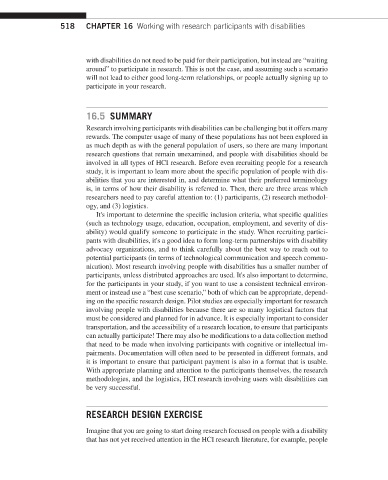Page 525 -
P. 525
518 CHAPTER 16 Working with research participants with disabilities
with disabilities do not need to be paid for their participation, but instead are “waiting
around” to participate in research. This is not the case, and assuming such a scenario
will not lead to either good long-term relationships, or people actually signing up to
participate in your research.
16.5 SUMMARY
Research involving participants with disabilities can be challenging but it offers many
rewards. The computer usage of many of these populations has not been explored in
as much depth as with the general population of users, so there are many important
research questions that remain unexamined, and people with disabilities should be
involved in all types of HCI research. Before even recruiting people for a research
study, it is important to learn more about the specific population of people with dis-
abilities that you are interested in, and determine what their preferred terminology
is, in terms of how their disability is referred to. Then, there are three areas which
researchers need to pay careful attention to: (1) participants, (2) research methodol-
ogy, and (3) logistics.
It's important to determine the specific inclusion criteria, what specific qualities
(such as technology usage, education, occupation, employment, and severity of dis-
ability) would qualify someone to participate in the study. When recruiting partici-
pants with disabilities, it's a good idea to form long-term partnerships with disability
advocacy organizations, and to think carefully about the best way to reach out to
potential participants (in terms of technological communication and speech commu-
nication). Most research involving people with disabilities has a smaller number of
participants, unless distributed approaches are used. It's also important to determine,
for the participants in your study, if you want to use a consistent technical environ-
ment or instead use a “best case scenario,” both of which can be appropriate, depend-
ing on the specific research design. Pilot studies are especially important for research
involving people with disabilities because there are so many logistical factors that
must be considered and planned for in advance. It is especially important to consider
transportation, and the accessibility of a research location, to ensure that participants
can actually participate! There may also be modifications to a data collection method
that need to be made when involving participants with cognitive or intellectual im-
pairments. Documentation will often need to be presented in different formats, and
it is important to ensure that participant payment is also in a format that is usable.
With appropriate planning and attention to the participants themselves, the research
methodologies, and the logistics, HCI research involving users with disabilities can
be very successful.
RESEARCH DESIGN EXERCISE
Imagine that you are going to start doing research focused on people with a disability
that has not yet received attention in the HCI research literature, for example, people

